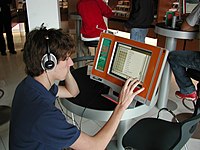
Photo from wikipedia
Touchscreen sensors are widely used in many devices such as smart phones, tablets, laptops, etc. We present the design, analysis, and implementation of an ultrasonic touchscreen system that utilizes interaction… Click to show full abstract
Touchscreen sensors are widely used in many devices such as smart phones, tablets, laptops, etc. We present the design, analysis, and implementation of an ultrasonic touchscreen system that utilizes interaction of transient Lamb waves with objects in contact with the screen. The governing principle revolves around the propagation and reverberation of guided elastic waves in a bounded space, in which the localization of touch points can be challenging. Reverberant fields in enclosures can potentially carry useful information, however, in an incoherent way. Incoherency comes from consecutive reflections of the wave energy several times in the domain, ultimately leading to mixing of the wave energy in a seemingly random way. However, spreading of the wave energy can lead to multiple interrogations of each point in the enclosure. Hence, temporal information buries information about substructural changes making it feasible to conduct only a few spatial measurements. We present a learning localization algorithm...
Journal Title: Journal of the Acoustical Society of America
Year Published: 2017
Link to full text (if available)
Share on Social Media: Sign Up to like & get
recommendations!